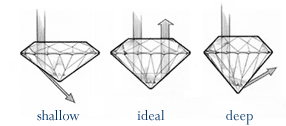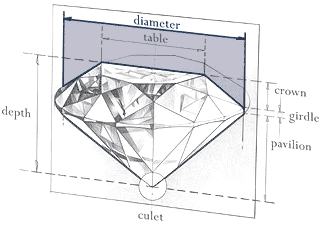The 4 C’s
When searching for that special diamond it is important to understand where it’s value comes from. There are 4 characteristics in particular that explain the true quality and value of a diamond: Cut, Clarity, Color, and Carat Weight
Cut
The cut of a diamond refers, first of all, to its shape. Diamonds are cut into many different shapes, reflecting not only popular taste but the proportions and quality of the rough stone. The most popular shapes include Round, Oval, Princess, Emerald, and Marquise cuts. Many specialty shapes like the Pear, Radiant, Cushion, and Heart cuts are also available.
Cut also refers to a diamond’s overall proportions, as well as the size and placement of its many reflective surfaces, known as facets. The consistency and balance of these facets can greatly affect how the stone captures light and reflects it back to the eye. This is what jewelers refer to as brilliance- the unique light show produced by a fine diamond. Most gemologists consider cut the most important diamond characteristic because even if a diamond has perfect color and clarity, a diamond with a poor cut will have dulled brilliance.
The width and depth have the greatest effect on how light travels within the diamond, and how it exits in the form of brilliance.

Too Shallow: Light is lost out the bottom causing the diamond to lose brilliance.
Too Deep: Light escapes out the sides causing the diamond to appear dark and dull.
Cut Determines Brilliance
The diamond’s proportions, specifically the depth compared to the diameter, and the diameter of the table compared to the diameter of the diamond, determine how well light will reflect and refract within the diamond.
Diamond Anatomy
 Diameter: The width of the diamond as measured through the girdle.
Diameter: The width of the diamond as measured through the girdle.
Table: The largest facet of a gemstone.
Crown: The top portion of a diamond extending from the girdle to the table.
Girdle: The narrow band around the widest part of a diamond.
Pavilion: The bottom portion of a diamond, extending from the girdle to the culet.Culet: The facet at the tip of a gemstone. The preferred culet is not visible with the unaided eye (graded “small” or “none”).
Depth: The height of a gemstone measured from the culet to the table.
